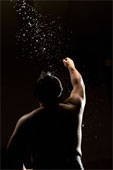Sumo is quintessentially Japanese. The wrestler is the ideal Japanese man: showing great strength, personal discipline and honor. For centuries, foreigners (gaijin) participated. Then, little by little, the door opened. The pioneer was Takamiyama Daigoro, a Hawaiian. He was the first to break into the upper ranks, and the first to have his own sumo stable, and did some foreign recruiting.
Konishiki (born Saleva'a Fualui Atisano) was a Hawaiian-born Japanese-Samoan wrestler. Takamiyama recruited him, and Konishiki was the first gaijin to reach Ozeki (champion) status. (He retired in 1997. I hear he now hosts a TV show and is a DJ. Kind of a cool life. Check out the link for more info.)
After that, more gaijin wrestlers got in the game. Arguably the most successful was Akebono Taro (born Chad Rowan.) He was a Hawaiian, too, and dominated the sport (along with his Japanese rival Takanohana) throughout the 1990s. He had a longstanding and strong career as Yokozuna (grand champion). Like Takamiyama, he was honored to be allowed to join the JSA (Japan Sumo Association) and worked as a coach in the Azumazeki stable. In fact, he trained Asashoryu, the recently departed Mongolian Yokozuna (grand champion).
Asashoryu is another story for another day, with his controversial style, but there's no question he plowed a wide swath to the top for other Mongolians and other nationalities (Bulgarian, etc.) to stomp through.
I guess I never thought of Sumo (also referred to as Ozumo, which puts the honorific prefix of the O in front of sumo) as being populated by anyone but Japanese men. But now it seems the JSA has had to start putting caps on the number of foreigners a stable can recruit. Like a lot of Japanese things, the Japanese like sumo to remain "unique" in the way only Japanese things can be unique.
Thursday, April 22, 2010
Subscribe to:
Post Comments (Atom)





The "O" at the beginning of Ozumo is not the honorific but the 大 character, meaning "big, grand, major, etc." In other words, Major League or professional sumo.
ReplyDeleteAlso, Konishiki is not Japanese-Samoan; he is of purely Samoan background, born, as you correctly write, in Hawaii.
Thank you, Tokyolily! You're so right! I appreciate your comments and corrections! I'm no expert, just a newbie enthusiast, and I welcome any help from wiser patrons of the art!
ReplyDelete